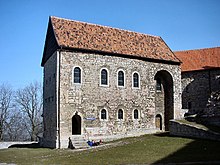Lohra Castle
| Lohra Castle | ||
|---|---|---|
|
Lohra Castle - ruins of the keep |
||
| Alternative name (s): | Groß Lohra, Großlohra, Schlossberg, Löhra | |
| Creation time : | 11th century | |
| Castle type : | Hilltop castle | |
| Conservation status: | Preserved essential parts | |
| Standing position : | Count | |
| Place: | Großlohra | |
| Geographical location | 51 ° 24 '50 " N , 10 ° 37' 49" E | |
| Height: | 410 m above sea level NN | |
|
|
||
The castle Lohra , even Großlohra, Großlohra, Schlossberg, Löhra called, is the ruins of a hilltop castle in Großlohra in the Thuringian district of Nordhausen . It is the castle of the Counts of Lohra from the 12th century and almost completely preserved with a high proportion of medieval buildings. Its double chapel from the Hohenstaufen era is particularly important .
history
The castle was built in the 11th century on a mountain spur at 410 m above sea level. NN built. The first reliable mention of the castle took place in 1116. In that year, a family of counts in the person of a Berengar, Count von Lare, was listed for the first time. However, it is believed that the castle is of much older origin.
Throughout the 12th century, the counts were closely associated with the Hohenstaufen dynasty. The counts held various royal offices which enabled them to expand the castle in a lavish style in the second half of the 12th century. Under Count Ludwig III. a large keep was built. The way the stone was set on the tower leads to the conclusion that a construction hut was active here that was influenced by the Hirsau building tradition. Another special building is the double chapel. It is a two-story chapel , the floors of which were connected by an opening in the middle. The upper floor was used by the rulers and the lower floor for the other castle residents as a prayer room. The architectural decoration of the chapel indicates stonemasons who also worked in nearby Königslutter .
Remains of a palace and an exceptionally strong curtain wall confirm the impression that the counts were planning to build a representative castle that did not need to shy away from comparison with the nearby Thuringian castles of Runneburg and Neuchâtel .
At the beginning of the 13th century the story of the Counts of Lohra tears down. Count Ludwig IV. Went on a crusade to the Holy Land together with Landgrave Ludwig IV. And probably perished there. The Counts of Lohra are no longer mentioned after this point in time.
The Counts of Beichlingen took over the rule and castle around 1227 . In 1320 they had to sell parts of the rule to the Counts of Hohnstein . They resided in the castle until they died out in 1593. The fortifications were reinforced several times under the Hohnstein family , especially at the beginning of the 15th century.
During the Thirty Years War , the castle was destroyed and rebuilt several times. Then it came to Johann VIII von Sayn-Wittgenstein-Hohenstein , then to the Hardenberg family .
The castle had been a Prussian domain since 1712 . A large number of renovations were carried out, in which the core castle often served as a quarry.
From the 1960s to the 1990s, Clara Döring, born in 1908, also known by the nickname "Burgfräulein", took care of the entire site. With the help of many volunteers, u. a. Döring carried out maintenance work as a ground monument curator . She also led numerous tourists around the site and published articles about the castle. In 1992, its Federal President Richard von Weizsäcker awarded the Federal Cross of Merit for her work in the preservation of monuments. Clara Döring died on July 2nd, 1994.
Renovation work has only recently been carried out.
Since 1992, the Weimar association “Open Houses e. V. “partly in cooperation with the working group for the preservation of monuments around the preservation of the Lohra Castle and offers cheap accommodation there for up to 80 people. The castle chapel was renovated in 2000 with funding from the German Foundation for Monument Protection .
literature
- Thomas Bienert: Reflections on the main castle of Lohra / Hainleite Castle in the 12th century (preliminary report) . In: Castles and Palaces in Saxony-Anhalt, Vol. 4., pp. 28 - 34 , Weimar 1995.
- Thomas Bienert: Medieval castles in Thuringia . Wartberg 2000, ISBN 3-86134-631-1 .
- Klara Döring: History of Lohra Castle . In: Meyenburg Museum (ed.): Contributions to local history from the city and district of Nordhausen . Issue 2/3. Nordhausen 1978, p. 86-100 .
- The chapel of Lohra Castle . In: home country. Illustrated sheets for the local history of the Grafschaft Hohenstein district, the Eichsfeld and the adjacent areas . No. 5, 1908. Online
Web links
Individual evidence
- ↑ BfN geospatial services
- ^ Friedrich von Sydow : Thuringia and the Harz. With their curiosities, folk tales and legends. Volume 7. 1842, p. 36 ( online ).
- ^ Thomas Müller: Clara Dörig - a life for Lohra Castle. Published in: Südharzer Fachwerkzentrum Nordhausen e. V. (Ed.): Nordhäuser Journal, No.2, March 2013, pages 28–31.
- ^ Ingrid Scheuermann, Katja Hofmann: Funding projects of the German Foundation for Monument Protection . Ed .: German Foundation for Monument Protection. tape 1 (sacred buildings). Monuments, Bonn 2012, ISBN 3-935208-10-3 , p. 313 .


